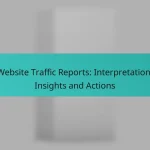A/B testing is an essential practice for businesses, enabling them to compare different versions of webpages or products to identify which one performs better. By leveraging data-driven insights, companies can make informed decisions that enhance their marketing strategies and drive profitability. Implementing effective A/B testing strategies, including clear objectives and audience segmentation, is key to optimizing conversion rates and achieving successful outcomes.

Why is A/B Testing important for businesses in the UK?
A/B testing is crucial for businesses in the UK as it allows them to compare two versions of a webpage or product to determine which performs better. This data-driven approach helps companies make informed decisions that can lead to improved outcomes and increased profitability.
Enhances decision-making
A/B testing enhances decision-making by providing clear evidence on what works best for your audience. Instead of relying on assumptions, businesses can analyze real user behavior and preferences, leading to more effective strategies.
For example, a UK retailer might test two different email marketing campaigns to see which one generates more clicks. The results can guide future marketing efforts and budget allocation.
Increases conversion rates
By identifying the most effective elements of a webpage or campaign, A/B testing can significantly increase conversion rates. Small changes, such as adjusting call-to-action buttons or altering headlines, can lead to noticeable improvements in user engagement.
Many businesses in the UK report conversion rate increases ranging from 10% to 30% after implementing A/B testing strategies, demonstrating its potential impact on sales and customer acquisition.
Reduces risks in marketing
A/B testing reduces risks in marketing by allowing businesses to experiment with new ideas on a smaller scale before full implementation. This approach minimizes the potential for costly mistakes and ensures that only the most effective strategies are rolled out.
For instance, a company might test a new pricing strategy on a small segment of its audience. If the results are positive, they can confidently apply the change across the broader market.
Improves user experience
Improving user experience is a key benefit of A/B testing, as it helps businesses understand what their customers prefer. By testing different layouts, content, and features, companies can create a more engaging and satisfying experience for users.
For example, a UK-based e-commerce site might find that a simpler checkout process leads to fewer cart abandonments, enhancing overall customer satisfaction and loyalty.
Drives data-driven strategies
A/B testing drives data-driven strategies by fostering a culture of experimentation and analysis within organizations. This approach encourages teams to rely on data rather than intuition, leading to more effective marketing and product development.
In the UK, businesses that adopt A/B testing often find that they can adapt more quickly to market changes and customer needs, ultimately staying ahead of competitors.

What are effective A/B Testing strategies?
Effective A/B testing strategies focus on structured approaches that yield actionable insights. By implementing clear objectives, audience segmentation, and reliable tools, businesses can optimize their marketing efforts and improve conversion rates.
Define clear objectives
Establishing clear objectives is crucial for successful A/B testing. Objectives should be specific, measurable, achievable, relevant, and time-bound (SMART) to guide the testing process effectively. For example, if the goal is to increase email sign-ups, define a target percentage increase within a set timeframe.
Without clear objectives, it becomes challenging to determine which variations are successful. Focus on one primary goal per test to maintain clarity and direction throughout the process.
Segment your audience
Segmenting your audience allows for more targeted A/B testing, leading to better insights. By dividing users based on demographics, behavior, or preferences, you can tailor variations to specific groups, enhancing relevance and engagement.
For instance, a retail website might test different promotions for new visitors versus returning customers. This approach helps identify which variations resonate best with each segment, ultimately driving higher conversion rates.
Test one variable at a time
Testing one variable at a time ensures that you can accurately attribute changes in performance to specific modifications. This method, known as a controlled experiment, minimizes confusion and provides clearer insights into what works.
For example, if you’re testing a landing page, change only the headline in one version while keeping other elements constant. This way, you can confidently assess the impact of the headline on user behavior.
Use reliable tools like Optimizely
Utilizing reliable A/B testing tools, such as Optimizely, simplifies the testing process and enhances accuracy. These platforms offer user-friendly interfaces, robust analytics, and integration capabilities, making it easier to set up and monitor tests.
When selecting a tool, consider factors like ease of use, support, and pricing. A good tool can significantly reduce the time and effort required to conduct effective A/B tests.
Analyze results thoroughly
Thorough analysis of A/B test results is essential to draw meaningful conclusions. After completing a test, review metrics such as conversion rates, click-through rates, and user engagement to evaluate performance against your objectives.
Look for statistically significant differences to ensure that your findings are reliable. Use this data to inform future strategies, optimizing your approach based on what has been proven to work. Avoid making decisions based solely on small sample sizes or inconclusive results.

How to choose the right A/B Testing tools?
Choosing the right A/B testing tools involves evaluating their usability, integration options, support services, and pricing. The right tool should align with your specific testing needs and enhance your overall marketing strategy.
Consider ease of use
When selecting A/B testing tools, prioritize ease of use to ensure your team can quickly adopt the software. Look for intuitive interfaces and straightforward setup processes that allow you to create tests without extensive training.
Tools with drag-and-drop functionality or pre-built templates can significantly reduce the time needed to launch tests. This is especially beneficial for teams with limited technical expertise.
Evaluate integration capabilities
Integration capabilities are crucial for A/B testing tools, as they need to work seamlessly with your existing marketing stack. Check if the tool can connect with your analytics platforms, email marketing services, and content management systems.
Tools that offer robust APIs or native integrations can streamline your workflow and enhance data accuracy, making it easier to analyze test results and implement changes based on insights.
Check for customer support
Reliable customer support can make a significant difference when using A/B testing tools. Look for providers that offer multiple support channels, such as live chat, email, and phone support, to assist you promptly when issues arise.
Additionally, consider the availability of resources like documentation, tutorials, and community forums, which can help you troubleshoot common problems independently.
Assess pricing structures
Pricing structures for A/B testing tools can vary widely, so it’s essential to assess what fits your budget while meeting your needs. Some tools offer tiered pricing based on features, while others may charge per test or user.
Evaluate the return on investment by considering the potential impact of improved conversion rates against the costs of the tool. Look for free trials or demo versions to test functionality before committing to a subscription.

What are common pitfalls in A/B Testing?
Common pitfalls in A/B testing can lead to misleading results and poor decision-making. Avoiding these mistakes is crucial for obtaining valid insights that can drive effective changes.
Insufficient sample size
Having an insufficient sample size is a frequent mistake that can skew results. A small sample may not accurately represent the larger population, leading to unreliable conclusions. Aim for a sample size that is large enough to detect meaningful differences, typically in the hundreds or thousands, depending on the expected effect size.
To determine the right sample size, consider using online calculators that factor in your conversion rates and desired statistical power. This ensures that your test results are robust and actionable.
Ignoring statistical significance
Ignoring statistical significance can result in overconfidence in A/B test outcomes. Results should be evaluated with a focus on p-values, typically aiming for a threshold of 0.05 or lower to confirm that observed differences are not due to random chance. Without this, you risk making decisions based on noise rather than true effects.
Utilizing tools that automatically calculate statistical significance can help avoid this pitfall. Always report both the results and their significance to provide a clearer picture of your findings.
Testing for too long
Testing for too long can introduce external factors that distort results, such as seasonal trends or changes in user behavior. A/B tests should generally run for a predetermined period, often a few weeks, to ensure that results are timely and relevant. Prolonged testing can lead to fatigue and variability that complicate analysis.
Establish clear timelines for your tests and stick to them. Regularly review progress to ensure that the test remains aligned with your objectives and that external influences are minimized.






